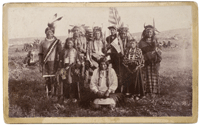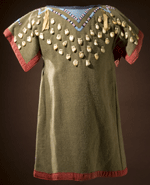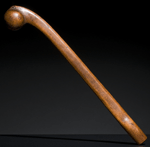|
Cowan's
Corner
Photographs Can Offer More Than Just a Thousand Words
By Wes Cowan
Collectors of American Indian art view their objects from two angles: as art
and as history. For example, the aesthetics of a war club easily transform it
into a sleek modern sculpture. When viewed in an historical context, however,
the club becomes a lethal weapon. Often, the history of an artifact increases
its value as a piece of art.
Ever since the invention of the daguerreotype
in 1837, photography has been an integral part of recording history and
capturing each ordinary day. Information seen in photographs places art and
antiques into a framework that may otherwise be missed or misunderstood.
Placing an object into a historical framework is more easily understood by
examining a boudoir card of a Sioux Family taken around 1890. If you look
closely, the earrings the women wear in the photograph are made with dentalium
shells. Dentalia were held in high esteem because they are found along the
northwest coast of North America and had to be traded into the interior, making
them more difficult to find. Their heavy use in ornamentation suggests to an
outsider that the family in the picture had wealth and prestige.
Other clues
about the status of the family pictured can be seen in the clothing. The little
girl to the right is wearing a wool dress decorated with cowrie shells. Cowrie
shells conveyed a similar status, in that the more shells on the garment, the
more influential the family. Cowrie shells came into favor after the relocation
of the American Indians to reservations in the late 19th century.
Before the
use of cowrie shells, American Indians preferred elk incisors. At times, entire
dresses would be covered with teeth. Considering that every elk has just two
incisors, a lot of elk had to be killed in order to adorn a dress completely.
The social status of having a child dressed in the finest shows well on both the
family and entire social group.
In a collector's eyes, owning a child's
dress with elk teeth would be more important than an unadorned dress or one with
only cowrie shells. Not only is it more valuable in today's market, but suggests
an earlier, pre-reservation time period in American Indian culture. This is a
case where both the history and the artistic detailing elevate the value to
figures near or above $10,000.
As ordinary as a day may seem, the
accumulation of ordinary days make history. History elevates both the interest
and value of antiques. Photographs offer great insight into past ordinary days.
 About the author: Wes Cowan is founder and owner of Cowan's Auctions, Inc. in Cincinnati, Ohio. An
internationally recognized expert in historic Americana, Wes stars in the PBS television
series History Detectives and is a featured appraiser on Antiques Roadshow. He can be
reached via email at info@cowans.com. Article research by Danica Farnand. About the author: Wes Cowan is founder and owner of Cowan's Auctions, Inc. in Cincinnati, Ohio. An
internationally recognized expert in historic Americana, Wes stars in the PBS television
series History Detectives and is a featured appraiser on Antiques Roadshow. He can be
reached via email at info@cowans.com. Article research by Danica Farnand.
|

Boudoir card of a Sioux Family.

Crow girl's dress decorated with elk teeth and cowrie shells, est.
$8,000-$10,000.

Great Lakes Ballhead club, estimated $3,000 |